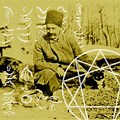




Making the Spiritual Connection
And there appeared unto him an angel of the Lord standing on the right side of the altar of incense.
St Luke 1:11
When using essential oils specifically for subtle healing or spiritual enhancement, create a special time to link with the divine energy of the universe. You may plan this, or intuitively decide 'this is the time' but whichever it is, approach it as sacred and special.
Mark it out in your mind as qualitatively different from the rest of the day. What you do in that time - in terms of it being a ceremony or ritual of some sort - is not as important as approaching it with right intention. Empty your mind of negativity, focus on the positive, and recognize the divinity in the energy that pervades all living things. Breathe deeply, slow down, and rest in infinite peace within yourself.
The Heavenly Atmosphere
.........among the ten thousand rites, the burning of incense has the primacy...........
Taoist Liturigical Text
In the Eastern spiritual traditions of Hinduism, Buddhism, Shinto and Taoism, the burning of incense is common place both during public worship at temples or shrines and at home. The earliest evidence for the burning of incense in China comes from the Shang dynasty, which was 1500-1066BC. Islam has also been very positive about the use of fragrance, partly because of these words ascribed to the prophet Mohammed: 'It has been given to me to love three things in your base world: women, perfume and prayer, but the apple of my eye is prayer.
' In Pakistan Muslims use incense during ceremonies of circumcision and marriage, and it's burnt from the moment a person dies until they are buried.'
The Western spiritual tradition of Judaism and Christianity, on the other hand, have historically been ambivalent about the religious use of fragrant materials, with different branches of the religions at different times, being for and against it. The early antipathy to the burning of incense, other than for priestly use, comes from the fact that the religious opposition - goddess worshippers - burnt incenses in some profusion.
In Ezekiel 8:9-14, for example, we hear how 'abominations' were taking place in the form of idol worship, with seventy elders, '....every man his censer in his hand; and a thick cloud of incense went up', with women weeping for Tammuz, lover of the goddess Ishtar, the 'Queen of Heaven'. These practices were already ancient at the time, having been imported from Babylon. The early Hebrews were also, of course, familiar with the burning of incense, which was an important aspect of Egyptian spiritual practice.
Incense-burning became central to Jewish ritual, but was controlled by the priests, starting with Moses and Aaron. In Exodus 30:34-37, God ordered Moses to make incense:
Greek Orthodox churches offer up incense every day, as well as at Eucharistic and sacramental worship. 'On a less formal level', explains Gregorios Archbishop of Thyateira and Great Britain, 'incense is used in the homes in a simple ritual in the morning and at sunset when a member of the household(usually the lady of the house) will offer prayers and incense in front of the family's icons and will take the incenses into each room of the house and also incense the members of the family. Even in those households where the daily offering of incense has less emphasis, the incense will be offered at sunset on Saturday and great festivals - sunset being the beginning of the new day in the Orthodox Church and therefore the beginning of the feat.
There are many types of incense used in homes around the world, such as incense sticks or cones and aromatic plant material placed on burning charcoal. People have different reasons - secular as well as sacred - for burning fragrance in their environment.
It's been used to 'fumigate' against insects and disease; simply as a perfume, for helping focus during meditation and when offering prayers. Whatever form it comes in, incense gets its aroma from the aromatic molecules of the plant materials from which it is derived - essential oils. When incense is burnt, there can be a great deal of smoke, which some people enjoy.
For those who don't essential oils provide another option.
There are many ways of using essential oils in an enclosed environment, but the most usual means is in a diffuser. How much essential oil you use will depend on the strength of the aroma required, the size of the area, and the power of the essential oil(s) being used.
Bearing these things in mind, use between 6-12 drops for an average -size room, or more if you wish.
It brings communication with the transcendent
Take unto thee sweet spices, stacte, and onycha, and galbanum; these sweet spices with pure frankincense: of each shall there be a like weight: And thou shalt make it a perfume, a confection after the art of the apothecary, tempered together, pure and holy:
And thou shalt beat some of it very small. and put of it before the testimony in the tabernacle of the congregation, where I will meet with thee; it shall be onto you most holy.
And as for the perfume which thou shalt make, ye shall not make to yourselves according to the composition thereof; it shall be unto thee holy for the Lord.
At the temple in Jerusalem, incense was offered twice a day on the Golden Altar in the Holy of the Sanctuary, and once a year before the Ark of the Covenant in the Holy of Holies - non Yom Kippur. The ingredients a re listed in the daily Siddur, in the early section of the offerings: Stacte, onycha, galbanum, frankincense, myrrh, cassia, spikenard, saffron, costus, aromatic bark and cinnamon. Each component of the incense is said to represent part of the community of Israel, and none may be ignored.
In the Christian tradition there has been, over the millennia, much argument about the use of incense.
Adverse associations may in part have derived from the fact that Christians were forced to burn incense before images of the Roman Emperors aaas evidence of imperial loyalty, or face execution. By the fifth century it was accepted as a symbol of prayer , but fell into disfavour after the Reformation began in 1517, when Martin Luther nailed his complaints against the theological establishment to a church door in Wittenberg, Germany.
Since then, there has been a great deal of debate, not to say division, between different Christian groups on the question of the use of incense, as well as other practices. Incense is today burnt in some Anglican churches, and is of course much used in Catholic churches. Revd Allen Morris kindly, told me, on the subject of incense, that, 'There is no attempt to lay down "recipes" by the church. The requirement simply is that when burnt, the incense should be able to symbolize the sweetness of Christ's sacrifice, as well as the prayers of the church rising to the throne of God.'
Let my prayer be set forth before Thee as incense.
Psalm 141:2
Greek Orthodox churches offer up incense every day, as well as at Eucharistic and sacramental worship. 'On a less formal level', explains Gregorios Archbishop of Thyateira and Great Britain, 'incense is used in the homes in a simple ritual in the morning and at sunset when a member of the household(usually the lady of the house) will offer prayers and incense in front of the family's icons and will take the incense into each room of the house and also incense the members of the family. Even in those households where the daily offering of incense has less emphasis, the incense will be offered at sunset on Saturday and great festivals - sunset being the beginning of the new day in the Orthodox Church and therefore the beginning of the feat.
There are many types of incense used in homes around the world, such as incense sticks or cones and aromatic plant material placed on burning charcoal. People have different reasons - secular as well as sacred - for burning fragrance in their environment.
It's been used to 'fumigate' against insects and disease; simply as a perfume, for helping focus during meditation and when offering prayers. Whatever form it comes in, incense gets its aroma from the aromatic molecules of the plant materials from which it is derived - essential oils. When incense is burnt, there can be a great deal of smoke, which some people enjoy.
For those who don't essential oils provide another option.
There are many ways of using essential oils in an enclosed environment, but the most usual means is in a diffuser. How much essential oil you use will depend on the strength of the aroma required, the size of the area, and the power of the essential oil(s) being used.
Bearing these things in mind, use between 6-12 drops for an average -size room, or more if you wish.
- It brings communication with the transcendent
- It purifies mind and body.
- It removes uncleanliness.
- It keeps you alert
- It can be a companion in the midst of solitude.
- In the midst of busy affairs, it brings a moment of peace.
- When it is plentiful, one never tires of it.
- When there is little, still one is satisfied.
- Age does not change its efficacy.
- Used every day it does no harm.
Ten Virtues of Koh (incense) compiled in the sixteenth-century Japan
Reference: The Fragrant Heavens: V.A.Worwood
Articles-Latest
- Koran burning conviction sparks fury as blasphemy law 'returns to UK'
- Robert Francis Prevost - Pope Leo XIV
- Pope Francis' death follows recent health challenges. Here's what we know about how he died.
- Easter April 2025 - international Celebrations
- The Rule of the twelve psalms -Worthy is the Lamb
- Religion in Africa Before Christianity and Islam
- 6 The Origin of Yahweh
- Dumo Di Milano
- What Did the Crow Tribe Believe In: Discover The Beliefs!
- 7 Reasons Historic Christianity Rejects the Book of Enoch
- 8 Breathtaking Mountain Monasteries Around the World
- Ethiopian Bible is oldest and most complete on earth
- Muhammad Muhammad was a prophet and founder of Islam.
- World Day of the Poor – SVP Christmas Campaign 2024
- Pope Francis to open 5 sacred portals on Christmas Eve — for a ritual that’s never been done before
- The 144,000 in Revelation
- Over 73 dead bodies 'used for meditation', 600 crocs in a pond, found in two Thai temples
- Occultism: Western Occult Tradition
- What is a Mudra
- Blood Sacrifices: Ancient Rituals of Life and Death
Articles-Most Read
- Home
- Let There Be Light
- Plants that feel and Speak
- The Singing Forest
- The Singing Forest-2
- Introduction
- Meditation
- Using Essential Oils for Spiritual Connection
- Heaven Scent
- Purification
- Plants that Feel and Speak-2
- Making the Spiritual Connection
- Anointing
- Essential Oils: The unseen Energies
- The Sanctity of Plants
- The Aroma Of Worship - Introduction
- The Aroma Of Worship-Foreward
- Methods Of Use
- Spiritual Blending
- Handling and Storage






